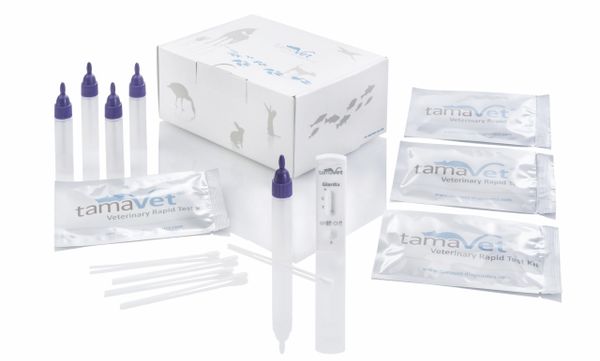Canine Parvovirus / Feline Panleukopenia Virus
| Product | Product code | Sample material | Detection |
|---|---|---|---|
| tamaVet® Parvovirus Test | 1172033N-05 | Faeces | Ag |
The tamaVet® Parvovirus Test is intended for the rapid detection of specific canine and feline parvovirus antigens in faecal samples taken from dogs and cats.
Both canine parvovirus (CPV2, 2a, 2b, 2c) and feline panleukopenia virus (FPV) belong to the Parvoviridae family. Transmission is usually oral or intrauterine.
Both CPV and FPV are highly contagious and most often acute infections (also known as ‘panleukopenia’ in cats). As the viruses depend on cells with a high rate of mitosis, they primarily attack intestinal cells, bone marrow, lymphatic tissue and myocardial cells. In puppies and kittens in particular, this can lead to severe systemic illness resulting initially in acute fever, watery/bloody diarrhoea, vomiting, anorexia and leucopenia followed by extreme dehydration and azotaemia, anaemia, hypoalbuminaemia and even panhypoproteinaemia. In rare cases, sudden death as a result of cardiovascular failure can occur, even without previous clinical signs. The detection of antigens is usually possible from the 3rd day and correlates with clinical symptoms.
The test is suitable for the early detection of suspected infection with parvovirus or in the case of clinical symptoms in dogs and cats.
Feline Immunodeficiency Virus (FIV)
| Product | Product code | Sample material | Detection |
|---|---|---|---|
| tamaVet® Feline Immunodeficiency Virus (FIV) Test | 1172034N-05 | Whole blood, serum, plasma | Ab |
The tamaVet® Feline Immunodeficiency Virus (FIV) Test is intended for the rapid detection of specific antibodies against the FIV-associated proteins p24 and gp41 in the whole blood, serum or plasma of cats. The feline immunodeficiency virus belongs to the Retroviridae family, and is usually transmitted through a bite.
In the acute or primary phase of the infection, which can last for days or weeks, young animals in particular experience lymphadenopathy and neutropenia as a result of the multiplication of the virus in T lymphocytes. This is often in conjunction with a fever. In the subsequent asymptomatic carrier phase, which can last months or years, no clinical symptoms are present. This is followed by a phase of numerous occurrences of secondary infections, known as AIDS-related complex (ARC). Symptoms affect the respiratory system and oral cavity, as well as the digestive tract. In the terminal phase (feline AIDS), anaemia, anorexia, pancytopenia and further secondary infections can be added to the list of symptoms. The detection of antibodies is possible from birth, though these may be maternal antibodies, and in the acute phase of infection the test may yield negative results. In the case of infection, detection is possible after approximately 8 to 12 weeks.
The test is suitable for the detection of antibodies against the FIV-associated proteins p24 and gp41 in the case of suspected infection or clinical symptoms. Positive tests in cats under 6 months old should be repeated after 6 to 8 months. It is generally advised to repeat the test after approximately 8 to 12 weeks.
Feline Leukaemia Virus (FeLV)
| Product | Product code | Sample material | Detection |
|---|---|---|---|
| tamaVet® Feline Leukaemia Virus (FeLV) Test | 1172035N-05 | Whole blood, serum, plasma | Ag |
The tamaVet® Feline Leukaemia Virus (FeLV) Test is intended for the rapid detection of feline leukaemia virus p27 (core protein) antigens in the whole blood, serum or plasma of cats.
The feline leukaemia virus belongs to the Retroviridae family, and can be transmitted vertically or, more commonly, through direct contact.
Once it has taken hold, the virus multiplies in four stages, beginning in the local lymphatic tissue and progressing to viraemia. In addition to multiplication in the spleen, lymph nodes and lymphatic tissue, it can also multiply in the bone marrow and epithelial cells, or even result in persistent viraemia. In the case of a regressive infection, the immune system is able to overcome the infection – however, the cat remains infected and in some cases resistance can develop. In the case of persistent viraemia, progressive infection can result in illness. The primary symptoms include tumours (such as lymphosarcomas, thymus or intestinal leukosis), neuropathies and reproductive disorders. Degenerative and immunosuppressive effects facilitate the onset of FeLV-associated diseases, the symptoms of which vary greatly. Chronic rhinitis or gingivitis, the slowed healing of wounds, pyodermia and a susceptibility to infections are all typical. The p27 antigen is produced during the early viraemic phase, approximately 14 to 30 days after infection, as well as during all subsequent stages.
The test is suitable for the rapid detection of feline leukaemia virus p27 antigens in the case of suspected infection or in the case of clinical symptoms, as well as for testing animals with an unknown immunisation status. If necessary, it is recommended to repeat the test.
Coronavirus
| Product | Product code | Sample material | Detection |
|---|---|---|---|
| tamaVet® Coronavirus Test | 1172037N-05 | Faeces | Ag |
The tamaVet® Coronavirus Test is intended for the rapid detection of specific canine and feline coronavirus antigens in the faecal samples of dogs and cats.
Canine coronavirus (CCoV) and feline coronavirus (FCoV) both belong to the Coronaviridae family and occur worldwide. The infections tend to be transmitted orally.
Coronaviruses demonstrate high recombination and mutation rates, which fosters new variants. Many infections are subclinical in dogs and cats, or cause only mild intestinal symptoms such as diarrhoea. Infections with clinical manifestations, primarily in puppies, kittens and other young animals, include apathy and anorexia, diarrhoea, dehydration, fever and, more rarely, heavily bloodied diarrhoea and even death. Its severity and duration in dogs and cats also depends on simultaneous parasitosis and mixed infections. The development of feline infectious peritonitis (FIP) is a fatal manifestation of an infection that only affects cats. The activation of macrophages and the complement system leads to inflammation of the vascular system and necrosis, with leakage of serum and proteins into the body cavities and fibrin deposition (effusive or wet form). A milder, more prolonged form without exudates may also occur, with nodular sites of inflammation in the organs (non-effusive or dry form). Clinical symptoms include anorexia and cachexia, as well as a recurrent fever that does not respond to treatment. The detection of antigens is usually possible around 3 to 14 days after infection.
The test is suitable for the early detection of suspected infection with coronavirus or in the case of clinical symptoms. As the excretion of coronavirus can be intermittent, repeated testing is recommended.
Giardia lamblia
| Product | Product code | Sample material | Detection |
|---|---|---|---|
| tamaVet® Giardia Test | 1172043N-05 | Faeces | Ag |
The tamaVet® Giardia Test is intended for the rapid detection of specific Giardia lamblia antigens in the faecal samples of dogs and cats.
Giardiasis is a disease caused by the unicellular parasite Giardia lamblia (also known as duodenalis/intestinalis). Infection with pathogen cysts by oral absorption mainly takes place following environmental contamination with faeces and reinfection during grooming.
After the cysts have been ingested, trophozoites are released into the gastrointestinal tract and adhere to small intestinal cells where they multiply by dividing into two. This leads to villous atrophy and the desquamation of epithelial cells with resulting malabsorption and maldigestion. The trophozoites in the rectum then form cysts again. Giardia infections are often asymptomatic in dogs and cats, though persistent and intermittent diarrhoea with light-coloured, foul-smelling faeces with mucus and blood admixtures can occur -especially in puppies, kittens and other young animals. Vomiting is less common. A loss of appetite and emaciation can happen in acute- to chronic cases. The period between infection and the excretion of trophozoites and cysts is 4 to 15 days.
The test is suitable for the early detection of suspected Giardia lamblia or in the case of clinical symptoms. As excretion can be intermittent, examinations should be carried out over a period of approximately 7 to 10 days and be repeated if necessary.
Multi 2TA (FeLV & FIV)
| Product | Product code | Sample material | Detection |
|---|---|---|---|
| tamaVet® Multi 2TA Test | 1172036N-05 | Whole blood, serum, plasma | Ag/Ab |
The tamaVet® Multi 2TA (FeLV, FIV) is intended for the rapid detection of feline leukaemia virus p27 antigens (core protein) as well as specific antibodies against FIV-associated proteins p24 and gp41 in the whole blood, serum or plasma of cats.
Both viruses belong to the Retroviridae family. Feline leukaemia virus can be transmitted vertically or, more commonly, through direct contact, whereas feline immunodeficiency virus is usually transmitted by bites.
As both infections have degenerative and immunosuppressive effects which can lead to similar secondary infections with comparable symptoms, it is recommended to combine both tests. The feline leukaemia virus p27 antigen is produced during the early viraemic phase, approximately 14 to 30 days after infection, as well as in all subsequent stages. The detection of antibodies against FIV-associated proteins p24 and gp41 is possible from birth, though these may be maternal antibodies, and in the acute phase of infection the test can be negative. Infection is detectable after approximately 8 to 12 weeks.
The test is suitable for the detection of feline leukaemia virus p27 antigens as well as antibodies against the FIV-associated proteins p24 and gp41 in the case of suspected infection or clinical symptoms. If necessary, repeating the test is recommended.
Multi 2TB (Coronavirus & Parvovirus/Panleukopenia Virus)
| Product | Product code | Sample material | Detection |
|---|---|---|---|
| tamaVet® Multi 2TB Test | 1172038N-05 | Faeces | Ag |
The tamaVet® Multi 2TB (Coronavirus, Parvovirus) Test is intended for the rapid detection of specific canine and feline coronavirus and parvovirus antigens in the faecal samples of dogs and cats.
Both canine coronavirus (CCoV) and feline coronavirus (FCoV) belong to the Coronaviridae family and occur worldwide. The infection tends to be transmitted orally. Both canine parvovirus (CPV2, 2a, 2b, 2c) and feline panleukopenia virus (FPV) belong to the Parvoviridae family. Transmission is usually oral or intrauterine.
As mixed infections often have similar symptoms such as apathy, anorexia, diarrhoea, dehydration and fever, a combination of both tests is recommended. Antigens can usually be detected approximately 3 to 14 days after infection.
The test is suitable for the early detection of suspected infection with coronavirus or parvovirus or in the case of clinical symptoms. As the excretion of parvovirus decreases, and the excretion of coronavirus can be intermittent, the test should be repeated after 2 days.
Multi 2TD (Giardia & Cryptosporidium parvum)
| Product | Product code | Sample material | Detection |
|---|---|---|---|
| tamaVet® Multi 2TD Test | 1172067N-05 | Faeces | Ag |
The tamaVet® Multi 2 TD (Giardia, Cryptosporidium parvum) Test is intended for the rapid detection of specific Giardia lamblia and Cryptosporidium parvum antigens in faecal samples taken from dogs and cats.
Giardiasis is a disease caused by the single-cell parasite Giardia lamblia (also known as duodenalis/intestinalis). Infection with pathogen cysts by oral absorption mainly takes place following environmental contamination with faeces and reinfection during grooming. The protozoan Cryptosporidium parvum belongs to the phylum Apicomplexa and forms infectious oocysts. The infection is normally transmitted orally.
As with Giardia lamblia cysts, the uptake of cryptosporidia oocysts leads to the release of sporozoites that attack the intestinal enterocytes and multiply in different stages, eventually releasing very environmentally stable oocysts. As with giardiasis, this can lead not only to malabsorption and maldigestion, but also to abdominal pain, vomiting and fever. In immunosuppressed animals in particular, or in puppies and kittens, potentially fatal diarhhoea can occur. In the case of Giardia lamblia, the time from infection to the excretion of trophozoites and cysts is 4 to 15 days, and 2 to 14 days in the case of Cryptosporidium parvum.
The test is suitable for the early detection of suspected Giardia lamblia and Cryptosporidium parvum, or in the case of clinical symptoms. As excretion is intermittent, examinations should be carried out over a period of approximately 4 to 10 days, and repeated as necessary.

